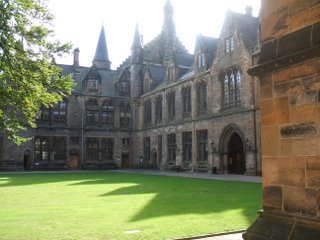
Founded in 1451, GU is the fourth oldest english-speaking university in existence and the second oldest in Scotland (St. Andrews has us beat by a few decades.)
This picture is of the east quad. Not only does the west quad look just as fantastic, the archway separating the two continues to give me goosebumps.

While most of this extensive campus continues in both Gothic and Victorian styles, there are a few unfortunate and unpictured exceptions. Sadly, this includes the Adam Smith concrete slab (my home for the next year) which only narrowly misses winning the "ugly building on campus award."

This"beauty shot" of the main tower was taken from the north end of university ave - one of my favorite spots.
I was pleasantly surprised to discover that the campus really blended in with the surrounding area. Much of the West End and City Centre was built during the late 19th century when Glasgow was the second wealthiest city in the British Empire. As a result, the architecture is primarily Victorian, though some Georgian structures remain.
Of course, by the 1960s the stonework was black from decades of pollution resulting from the extensive industry in the city and coal burning heating of many homes. One Glaswegian I spoke with recalled that during this time it was necessary to wear an oxygen mask just to breath. Pollution combined with the fog making visibility nil.
After the passage of the clean air act in the UK which banned coal burning stoves, the air quality in Glasgow and other industrial cities dramatically improved. In the 80s the city began cleaning the grime off the old buildings and discovered the gorgeous sandstone underneath.
This is not the city of William Wallace and Rob Roy. Rather, much of historic Glasgow is a indicative of the time when Britain was the superpower of the world and young men were expected upon completing university studies to continue the reach of the empire. Might this evidence of past glories be more accurately a silent tribute to a man who transformed the world with an invisible hand?

No comments:
Post a Comment